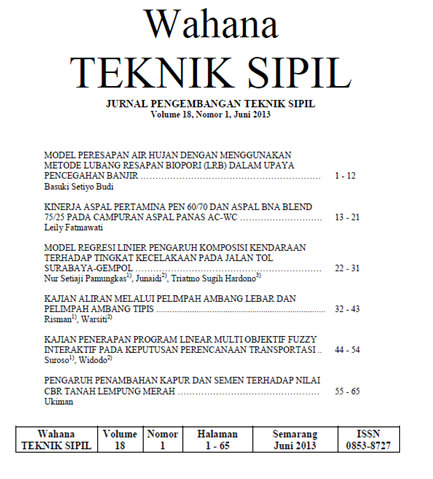Model Regresi Linier Pengaruh Komposisi Kendaraan Terhadap Tingkat Kecelakaan Pada Jalan Tol Surabaya-Gempol
DOI:
https://doi.org/10.32497/wahanats.v18i1.122Keywords:
traffic accidents, road tolls, multiple linear regression, the distribution of vehicle classes, the frequency rate of accidentsAbstract
Traffic accident is an event in which the unexpected and accidental, involve vehicles with or without other road users, resulting in loss of life or loss of property. The increasing number of vehicles as well as variation of the type and size of four or more wheeled vehicles of various dimensions and specifications of the vehicle, different speeds, driver behavior is not the same that would potentially cause symptoms that lead to the occurrence of traffic accidents on the freeway. This study aimed to determine the effect of the composition of vehicles in traffic flow on the highway accident rate in Surabaya-Gempol. Class composition of vehicles passing through the toll road will be analyzed influence on the rate of accidents (accident frequency = AF). This research is a study area toll roads Surabaya - Gempol that toll roads are divided into 2 lanes and 3 lanes. The method used in this study is the method of multiple linear regression analysis. Results of multiple linear regression analysis showed that only 1 of 4 linear regression model that showed that the variable composition of the vehicle has a significant effect on the frequency rate of accidents. While the other three regression models show the opposite result. This menunujukkan that improper linear regression model to predict the relationship between the independent variable composition with the vehicle accident rate on the highway Surabaya-Gempol.
Downloads
Published
Issue
Section
License
Authors who publish with this journal agree to the following terms:Authors retain copyright and grant the journal right of first publication with the work simultaneously licensed under a Creative Commons Attribution License that allows others to share the work with an acknowledgement of the work's authorship and initial publication in this journal.
Authors are able to enter into separate, additional contractual arrangements for the non-exclusive distribution of the journal's published version of the work (e.g., post it to an institutional repository or publish it in a book), with an acknowledgement of its initial publication in this journal.
Authors are permitted and encouraged to post their work online (e.g., in institutional repositories or on their website) prior to and during the submission process, as it can lead to productive exchanges, as well as earlier and greater citation of published work (See The Effect of Open Access).






